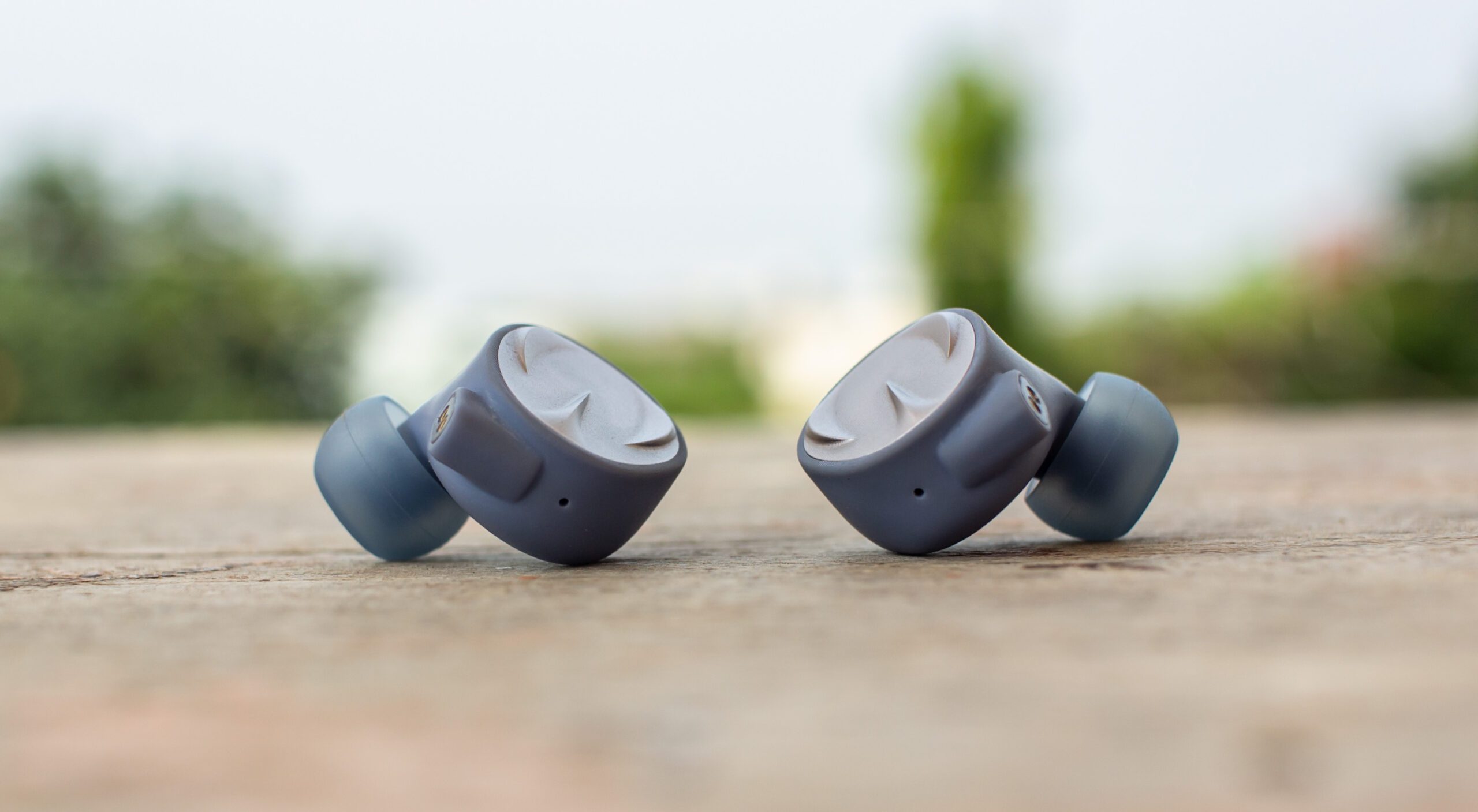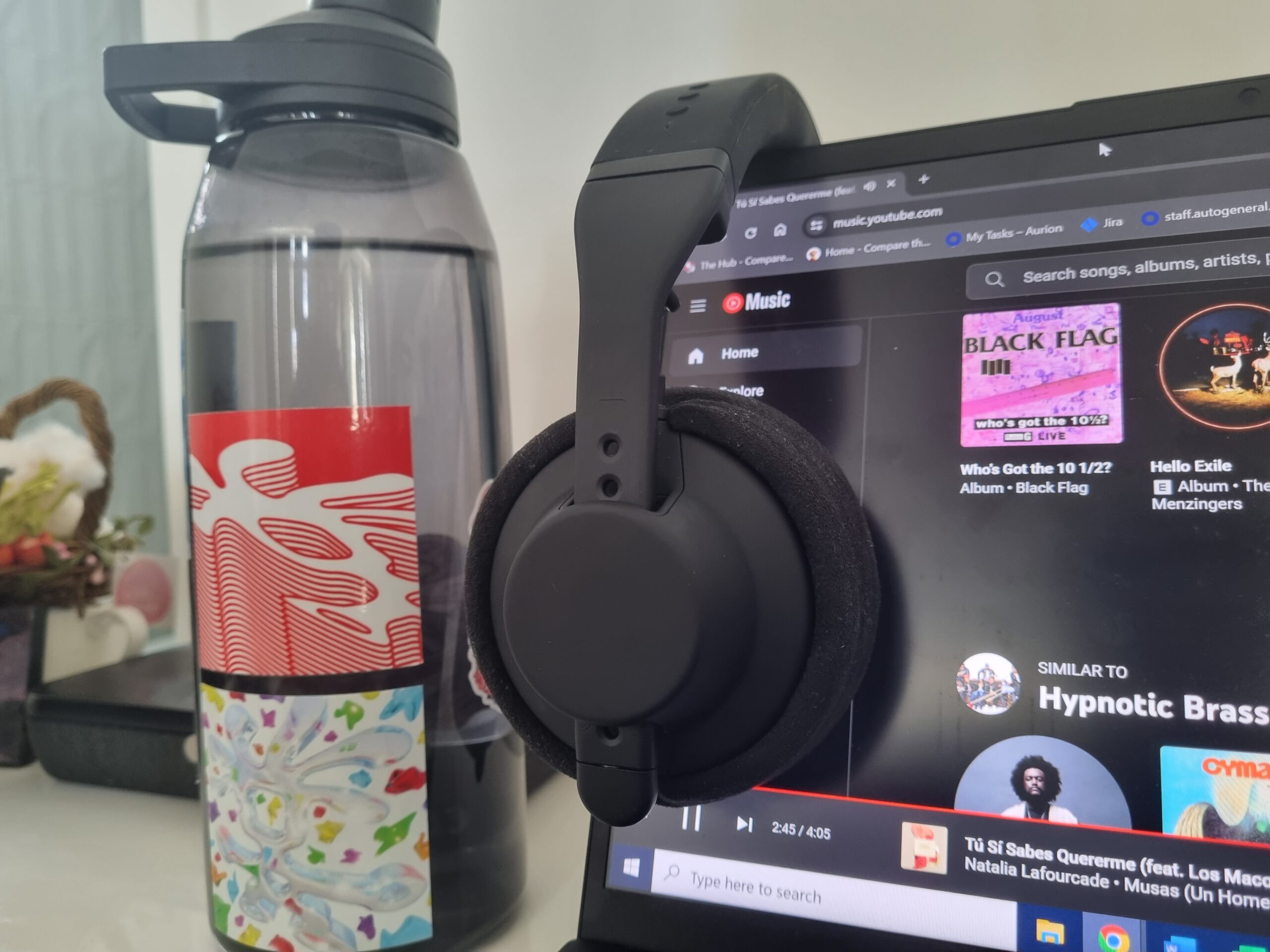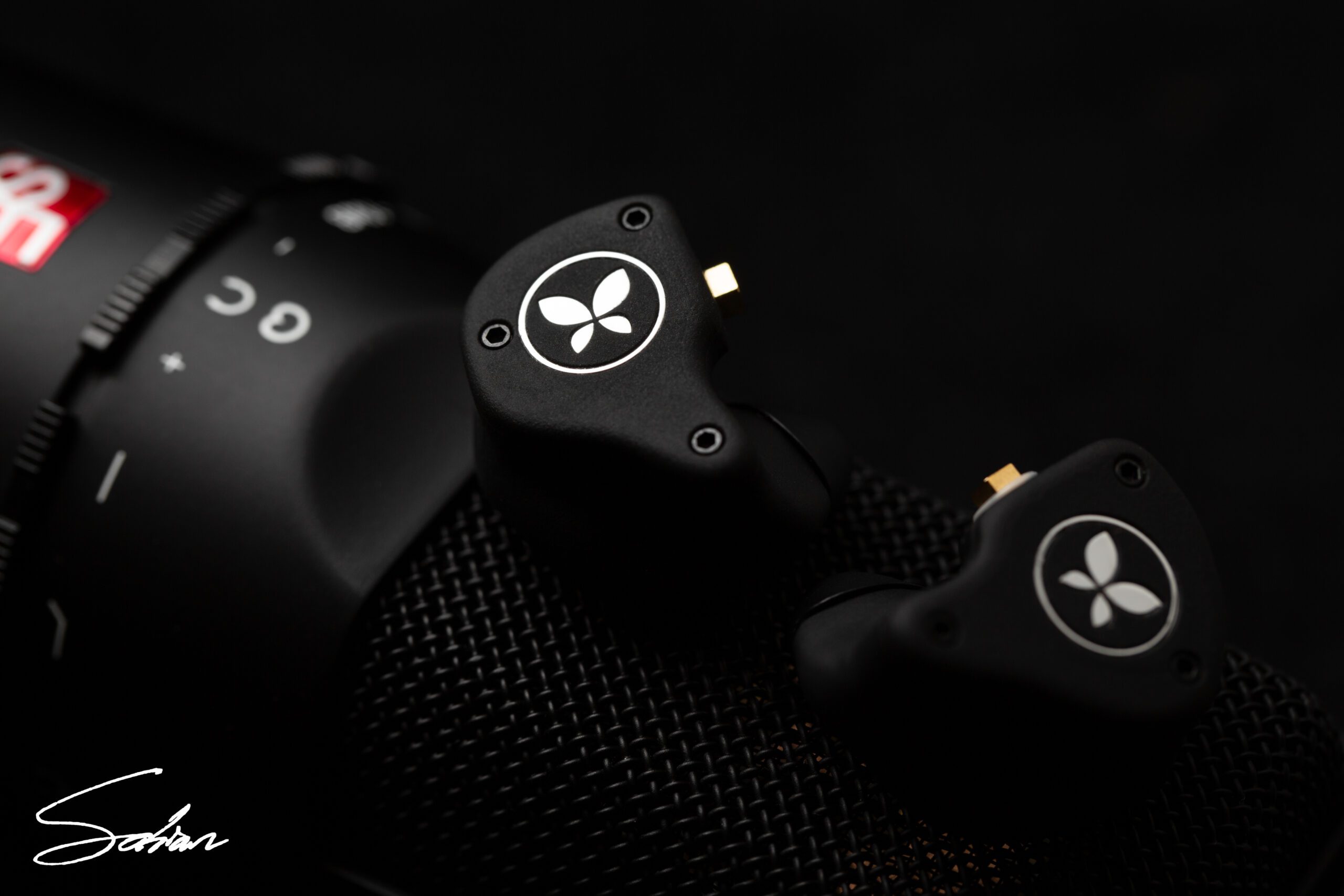Details: dual-driver follow-up to Phonak’s renowned Perfect Fit Earphone
MSRP: $599.00 (discontinued)
Current Price: $599 from amazon.com mic cable with 3-button remote included (discontinued)
Specs: Driver: Dual BA | Imp: 47Ω | Sens: 104-109 dB | Freq: 5-17k Hz | Cable: 3.9′ L-plug
Nozzle Size: 3mm | Preferred tips: stock silicone, stock Comply, Shure Gray Flex
Wear Style: Over-the-ear
Accessories (5/5) – Silicone single-flange tips (3 sizes), Comply foam tips (3 sizes), 8 tuning filters (4 grey; 2 black; 2 green) & filter changing tool, cleaning tool, silicone ear guides, replacement cable with inline mic/remote, and zippered carrying case
Build Quality (5/5) – While the housings of the PFE 232 are plastic, they are very well put-together and the finish is top notch. The cable is flexible, tangle-resistant, thick below y-split, and – most importantly – detachable. A spare mic cable is included in the package
Isolation (3/5) – Average with the included silicone tips but better with the Complys and some aftermarket tips
Microphonics (4.5/5) – Very low with the intended over-the-ear wear
Comfort (5/5) – Though the in-ear footprint of the 232 is a bit larger than that of the older PFE models, the earphones are still very lightweight and ergonomic and can really disappear during everyday use. The cable can be a little resistant to staying behind the ear but the fit is very secure with the included cable guides
Sound (9.2/10) – Released in 2008, Phonak’s original PFE has been widely revered for offering accurate sound in a lightweight, highly ergonomic form factor at a price that all but obliterated the competition. Those days are long gone – the PFE still sounds excellent but has appreciated in price and no longer leaves as large a berth between itself and its rivals. The original PFE made excellent use of a single armature, so it’s not surprising that the PFE 232, the company’s first all-new earphone since 2008, is a “mere” dual BA despite its ambitious price tag.
The sound of the PFE 232 has been re-tuned to offer a fuller, weightier musical experience without sacrificing accuracy. Like the first PFE, it utilizes a tuning system comprised of three sets of color-coded nozzle filters. The gray and black filters are similar to those included with the original PFE and the green filters are adapted from the cheaper Perfect Bass model.
The bass-heavy green filters attenuate the midrange and a bit of the treble in order to bring the low end forward. Like the original PFE, the 232 is not very efficient to begin with, but the green filters still manage to increase acoustic impedance noticeably. They provide a warmer, bassier sound at the expense of a portion of the transparency and resolution of the PFE 232. Compared to the gray filters, the green ones are muddier, with veiled, somewhat muffled-sounding mids, a more v-shaped response, and less air. The PFE 232 with the green filters still boasts less bass than the pricier AKG K3003 with its ‘Bass Boost’ filters does, as well as a more recessed midrange and brighter, harsher treble. As with the previous PFE model and the K3003, I feel that the bass-heavy configuration of the 232 sacrifices too much of what makes the earphone special, and that if I were willing to accept a poorer-sounding earphone in exchange for a little more bass, the $600 Phonaks would not be in consideration.
Happily, the black and gray filters of the 232 provide a more agreeable audio experience. While the black filters still de-emphasize the midrange and upper midrange for a more v-shaped response compared to the gray ones, they are far more tolerable than the enhanced bass configuration. Most of the veil present with the green filters is lifted and the acoustic resistance seems to be closer to the more unimpeded gray filters. The gray filters are still the most transparent and – to my ears at least – the most balanced-sounding of the three. They do have the most treble energy, but only by a small margin. The entirety of the below review is based on the gray filters except where otherwise noted.
The low end of the PFE 232 is quite consistent between all of the different filters – whichever tuning is chosen, the bass remains controlled but very impactful for a BA-based monitor. Bass punch is reminiscent of the VSonic GR07, trailing slightly behind the AKG K3003 but beating out TWFK-based monitors such as the ATH-CK10 and VSonic GR01 without sacrificing any control. The dynamic-driver GR07 has a bit more deep bass in comparison but doesn’t sound quite as full and fleshed-out overall. Indeed, the PFE 232 sounds very dynamic at all times and strikes an excellent balance between body and tightness with its bass. It is quick and clean as a good BA-based monitor should be, but the note presentation is never thin. Compared to the Earsonics SM3, the bass of the PFE is noticeably cleaner and crisper-sounding, appearing a little less boomy despite similar power and weight. Taken as a whole, the bass of the PFE 232 is very solid – easily some of the best BA bass I’ve heard.
The low end of the PFE 232 is emphasized slightly in comparison to the mids. As a result, the earphone doesn’t sound quite as level as the VSonic GR07 and ATH-CK10 do. Indeed, even the original, single-driver Phonaks have better bass-midrange balance than the PFE 232. That said, the quality of the midrange is very good – it is detailed and very transparent – most so with the gray filters in place. It is not as warm and smooth as that of the Earsonics SM3 but sounds cleaner and clearer. Like the bass, the midrange does not overstep any boundaries – note weight is good and yet the PFE 232 sounds very crisp. It is slightly fuller than the TWFK-based ATH-CK10 and a bit more textured and refined than the VSonic GR07 and Final Audio Heaven A.
With the gray filters, the treble transition is reasonably smooth and the top end is highly reminiscent of the original Phonaks. The PFE 232 has a lot of treble energy, boasting plenty of sparkle and good extension. It reminds me of the VSonic GR07 in being a touch hot without sounding overly bright in terms of tone, and can occasionally accentuate the sibilance on a track. In comparison to the PFE 232, the AKG K3003 has just as much treble energy and similarly faultless resolution but tends to be smoother and less offensive with its ‘Reference’ filters in place. The Final Audio Heaven A, on the other hand, has noticeably less treble energy and sounds a touch grainy compared to the PFE 232.
The presentation of the PFE 232 is very well-rounded – the soundstage has good width and depth, great separation, and believable, versatile imaging. It is much more conventional compared to the enveloping presentation of the Earsonics SM3 and yet loses only a bit of headstage size. The PFE 232 is not overly intimate and boasts a good center image, with better layering and a more 3D sense of space than the VSonic GR07, though not quite to the level of the AKG K3003. The K3003 is also airier and more open-sounding, with slightly better reach up top and great dynamics that make it more involving at the lowest volumes.
The above comparisons are based on A:B listening with the PFE 232 and a slew of top-tier universals. Priced as it is, however, the PFE 232 competes directly with quite a few custom monitors as well, even with the cost of ear impressions factored in. Below are short comparisons between the PFE 232 and the Clear Tune Monitors CTM-200 ($350) and Alclair Reference ($500).
A dual-driver custom monitor from Florida-based Clear Tune Monitors, the CTM-200 follows a balanced sound signature with a neutral tone. Compared to the slightly v-shaped PFE 232, the CTM-200 is flatter and more level, with mids that are not recessed and smoother treble. Its bass is a touch quicker but significantly lower in impact and not as extended as that of the Phonaks. The tone is a little cooler with the CTMs and the transparency is slightly better on the whole. In addition, the presentation is more spacious and the imaging is a tiny bit more convincing.
The Alclair Reference is a triple-driver earphone with solid bass and a warmer tone. It has very similar bass punch and clarity to the PFE 232 but offers up more pronounced mids and a less v-shaped signature. The top end of the Reference is similarly hot but the treble peaks come in lower, making it slightly more prone to vocal sibilance. The mids are warmer, drier, and a little more textured compared to those of the PFE and the presentation is larger and a bit more convincing in terms of positioning.
Value (8/10) – Phonak’s dual-driver follow-up to one of the best single-armature earphones on the market is a top-tier performer in every sense. The PFE 232 sounds excellent, though it differs greatly in signature from most of the top-tier Westone, Shure, and Etymotic monitors. Some listeners may be bothered by the slightly v-shaped signature and the edgy, revealing treble presentation but the PFE 232 provides some of the best bass I’ve heard from a universal and the clarity and resolution continuously impress. Plus, from the interchangeable cables to the lightweight, ergonomic housing design, the PFE 232 is one of the finest overall packages out there, making it worthy of recommendation despite Phonak’s ambitious pricing.
Pros: Very well-built with detachable cables, including a spare; lightweight & comfortable; clear sound with excellent bass and three tunings
Cons: Enhanced-bass tuning a step below the others; not as well-balanced as cheaper 112 model




5 Responses
Hi, it was sad when they discontinued their iem range. I went through 3-4 replacement cables on the PFE-232. But I loved the sound signature on them. Question, what would be a good replacement iem (within the same price range; USD500 – 800) for the PFE-232 (with a similar sound signature? I loved the detail and sound stage on my PFE-232, with its particular emphasis on string instruments.
Also, would there be a supplier capable of recabling my old PFE-232? Thanks for your time.
Sorry I haven’t been checking this website for a while, but the earphones sold out in a few days anyway. Sorry for answering so late.
-Frank
Can you tell me where the 60% off sale is running? Thanks
That’s a shame about the W40s.
The PFEs actually sound very different, I would almost say the opposite of the Westones. W40s tend to have a bit of a mid-bass hump and are on the warm side tonally, with pretty smooth treble and strong mids. The PFE232 has more emphasis on treble and less on the midrange, resulting in a brighter, more v-shaped sound. Bass is still very good, though.
For more balanced sound with a slight bass boost in that price range you might consider the VSonic GR07 Bass Edition, which is an excellent value for money (though like the PFE 232 it’s not as smooth as your Westones were) or the Fidue A83.
Links:
https://theheadphonelist.com/headphone_review/vsonic-gr07-bass-edition/
https://theheadphonelist.com/headphone_review/fidue-a83/
Hi LJOKERL,
I recently lost my W40s on the plane and audeo is having a 60% sale. How would the pfe 232’s compare? Would there be a better option in the 200-300 dollar range? I mostly listen to alternative rock. I usually like somewhat neutral IEMs with a little bass bump. Thank you so much in advance, your site really helped me pick out my IEMs last time around.
-Frank